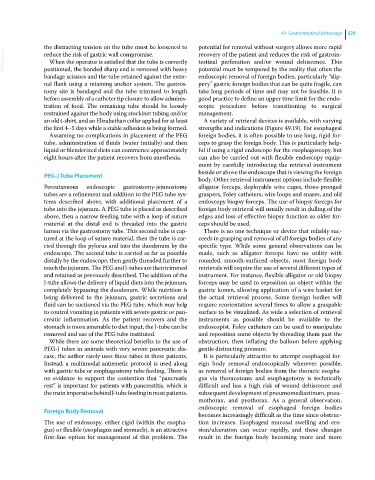Page 561 - Clinical Small Animal Internal Medicine
P. 561
49 Gastrointestinal Endoscopy 529
the distracting tension on the tube must be loosened to potential for removal without surgery allows more rapid
VetBooks.ir reduce the risk of gastric wall compromise. recovery of the patient and reduces the risk of gastroin-
When the operator is satisfied that the tube is correctly
testinal perforation and/or wound dehiscence. This
positioned, the bonded sharp end is removed with heavy
endoscopic removal of foreign bodies, particularly “slip-
bandage scissors and the tube retained against the exter- potential must be tempered by the reality that often the
nal flank using a retaining anchor system. The gastros- pery” gastric foreign bodies that can be quite fragile, can
tomy site is bandaged and the tube trimmed to length take long periods of time and may not be feasible. It is
before assembly of a catheter tip closure to allow adminis- good practice to define an upper time limit for the endo-
tration of food. The remaining tube should be loosely scopic procedure before transitioning to surgical
restrained against the body using stockinet tubing and/or management.
an old t‐shirt, and an Elizabethan collar applied for at least A variety of retrieval devices is available, with varying
the first 4–5 days while a stable adhesion is being formed. strengths and indications (Figure 49.19). For esophageal
Assuming no complications in placement of the PEG foreign bodies, it is often possible to use long, rigid for-
tube, administration of fluids (water initially) and then ceps to grasp the foreign body. This is particularly help-
liquid or blenderized diets can commence approximately ful if using a rigid endoscope for the esophagoscopy, but
eight hours after the patient recovers from anesthesia. can also be carried out with flexible endoscopy equip-
ment by carefully introducing the retrieval instrument
beside or above the endoscope that is viewing the foreign
PEG‐J Tube Placement
body. Other retrieval instrument options include flexible
Percutaneous endoscopic gastrostomy‐jejunostomy alligator forceps, deployable wire cages, three‐pronged
tubes are a refinement and addition to the PEG tube sys- graspers, Foley catheters, wire loops and snares, and old
tems described above, with additional placement of a endoscopy biopsy forceps. The use of biopsy forceps for
tube into the jejunum. A PEG tube is placed as described foreign body retrieval will usually result in dulling of the
above, then a narrow feeding tube with a loop of suture edges and loss of effective biopsy function so older for-
material at the distal end is threaded into the gastric ceps should be used.
lumen via the gastrostomy tube. This second tube is cap- There is no one technique or device that reliably suc-
tured at the loop of suture material, then the tube is car- ceeds in grasping and removal of all foreign bodies of any
ried through the pylorus and into the duodenum by the specific type. While some general observations can be
endoscope. The second tube is carried as far as possible made, such as alligator forceps have no utility with
distally by the endoscope, then gently threaded further to rounded, smooth‐surfaced objects, most foreign body
reach the jejunum. The PEG and J‐tubes are then trimmed retrievals will require the use of several different types of
and retained as previously described. The addition of the instrument. For instance, flexible alligator or old biopsy
J‐tube allows the delivery of liquid diets into the jejunum, forceps may be used to reposition an object within the
completely bypassing the duodenum. While nutrition is gastric lumen, allowing application of a wire basket for
being delivered to the jejunum, gastric secretions and the actual retrieval process. Some foreign bodies will
fluid can be suctioned via the PEG tube, which may help require reorientation several times to allow a graspable
to control vomiting in patients with severe gastric or pan- surface to be visualized. As wide a selection of retrieval
creatic inflammation. As the patient recovers and the instruments as possible should be available to the
stomach is more amenable to diet input, the J‐tube can be endoscopist. Foley catheters can be used to manipulate
removed and use of the PEG tube instituted. and reposition some objects by threading them past the
While there are some theoretical benefits to the use of obstruction, then inflating the balloon before applying
PEG‐J tubes in animals with very severe pancreatic dis- gentle distracting pressure.
ease, the author rarely uses these tubes in these patients. It is particularly attractive to attempt esophageal for-
Instead, a multimodal antiemetic protocol is used along eign body removal endoscopically wherever possible,
with gastric tube or esophagostomy tube feeding. There is as removal of foreign bodies from the thoracic esopha-
no evidence to support the contention that “pancreatic gus via thoracotomy and esophagotomy is technically
rest” is important for patients with pancreatitis, which is difficult and has a high risk of wound dehiscence and
the main imperative behind J‐tube feeding in most patients. subsequent development of pneumomediastinum, pneu-
mothorax, and pyothorax. As a general observation,
endoscopic removal of esophageal foreign bodies
Foreign Body Removal
becomes increasingly difficult as the time since obstruc-
The use of endoscopy, either rigid (within the esopha- tion increases. Esophageal mucosal swelling and ero-
gus) or flexible (esophagus and stomach), is an attractive sion/ulceration can occur rapidly, and these changes
first‐line option for management of this problem. The result in the foreign body becoming more and more

